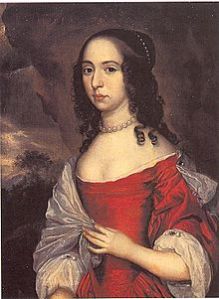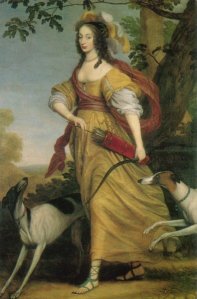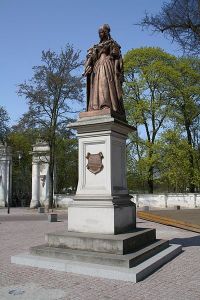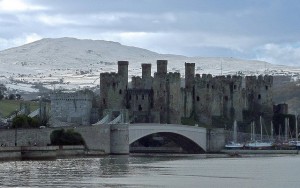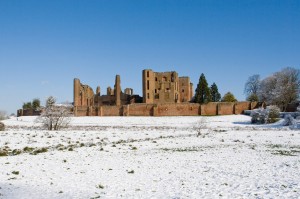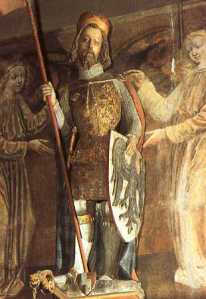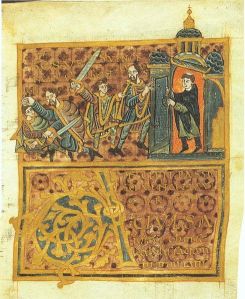Baldwin I of Jerusalem, formally Baldwin I of Edessa, born Baldwin of Boulogne, was born c.1058 in the Lower Lorraine region of France. He was one of the leaders of the first crusade and 1st Count of Edessa and first to be named King of Jerusalem once he gained power from his brother Godfrey of Boullion who refused the title of King.
Baldwin was the third son of Eustace II, Count of Boulonge and Ida of Lorraine. Being the youngest son he was intended for a life in the church but he had given this up by 1080; according to William of Tyre. Tyre didn’t know Baldwin and wrote later in the 12th century ‘in his youth, Baldwin was well nurtured in the liberal studies’. Afterwards he lived in Normandy, where he married Godehilde (or Godvera) de Toeni who was the daughter of Raoul de Conches a noble Anglo-Norman family. He returned to the Lower Lorraine in order to take control of the county of Verdun previously held by Godfrey.
In 1096 he went with his brothers Godfrey and Eustace IIII of Boulogne and joined the First Crusade. Baldwin raised funds for his expenses by selling most of his property to the church, and took his wife Godehilde with him. On the march to the Holy Lands when they reached Hungary, King Coloman demanded a hostage as a sign that the Crusaders would not wreak havoc on the lands as they passed through. Baldwin was chosen and was handed over to King Coloman until all the Crusaders had passed through Hungarian territory
When they entered into Byzantium land there were skirmishes with Greek troops and Baldwin commanded a troop of soldiers that captured a bridge close to Constantinople. On reaching Constantinople the mass of soldiers could not be controlled and went about the typical solder habit of pillaging the surrounding area. The Byzantium Emperor Alexius I Comnenus was forced to give a hostage who was taken into the care of Baldwin, his son and future emperor John II Comnenus.
At Heraclea in Asia Minor he broke away from his brothers and the main band of Crusaders and with Tancred (future Prince of Galilee) he marched into Cilicia. Then in September 1097 he takes Tarsus from Tancred with the help of Guynemer of Boulogne and his pirates. Tancred and Baldwin’s armies skirmished around Mamistra but never committed to full battles with Tancred finally leaving and marching towards Antioch. Baldwin then joined the main force again at Marash, Baldwin then received an invitation from an Armenian named Bagrat and moved eastwards towards the Euphrates, where he occupied Turbessel
Baldwin then received another invitation from Thoros of Edessa. Thoros adopted Baldwin as his own son and successor and after he was assassinated in March 1098 Baldwin became the first Count of Edessa. His wife Godehilde had died whilst on the journey to the Holy Land, and Baldwin then married Thoros of Marash’s daughter Arda, acting as an ambassador between the Crusaders and the Armenians. He ruled Edessa until 1100 and during these two years he captured Samosata and Surac from the Muslims. During the siege of Antioch he sent money and food to aid his fellow Crusaders but did not participate in the siege himself.
Kerbogha, the governor of Mosul, was marching towards Antioch to help with the relief, when he laid siege to Edessa for three weeks. Kerbogha was not successful in his siege and broke it heading later towards Antioch He was later defeated at Antioch which lead to the Crusaders being able to form a principality there. Later that year Baldwin with the aid of his brother Godfrey also besieged Azaz where they defeated the forces of Ridwan of Aleppo.
After Godfrey’s death in July 1100 Baldwin was invited to Jerusalem by supporters led by Warner of Graz. He granted Edessa to his cousin Baldwin of Bourcq. On his way to Jerusalem he was ambushed by the forces of Duqaq of Damascus near Beirut, but Baldwin defeated Duqaq continuing on his journey to Jerusalem, arriving in November 1100. Once he had arrived in Jerusalem he was opposed by his old enemy Tancred, as well as the new patriarch (head of the Catholic Church in Jerusalem) Dagobert of Pisa. On arrival he also set out on an expedition against the Egyptians to the south and didn’t return until December. On his return he was crowned as King of Jerusalem on Christmas Day in Bethlehem by Dagobert who had since given up his opposition. Baldwin was the first King of Jerusalem as Godfrey had refused the title saying there was only one King of Jerusalem that being Jesus Christ.
In 1101 Baldwin started a campaign of expanding his territory with capturing Arsuf and Caesarea. In September of that year he then defeated the Egyptians at the Battle of Ramlah. Mis-communication regarding the battle was rife and it had been believed in Jerusalem that the Crusader army had been defeated and Baldwin killed. Tancred was set to take up the regency when it was finally reported Baldwin was actually victorious.
In 1102 another battle was fought at Ramlah which included some of the original Crusaders including, Stephen of Blois, William IX Duke of Aquitaine and Hugh VI of Lusignan. This time the Egyptians were victorious and Baldwin lost many of his army; including Stephen of Blois. Baldwin managed to escape Arsuf on his horse, who we know was called Gazala. He quickly arranged for his transport back to Jaffa moving by boat, led by Godric of Finchale before managing to return to Jerusalem in secret. Baldwin then led another army against the Egyptians at Jaffa, this time winning the battle.
This led to Baldwin in 1103 besieging Acre without success with the city being relieved by an Egyptian fleet. This didn’t deter Baldwin who with the aid of a Genoese fleet besieged the city once more in 1104, this time taking the city. In 1105 another battle was fought at Ramlah and Baldwin was victorious once more. In 1109 he assisted with the council of great barons outside the city of Tripoli. The city was taken later that year setting up the County of Tripoli. In 1110 Beirut was added to the Kingdom of Jerusalem. Sidon was then captured with the aid of Ordelafo Faliero, with his Venetian fleet of 100 a hundred ships and Sigurd I of Norway. In 1113 he defeated the combined forces of Toghtekin of Damascus and Askunk-ur of Mosu, with assistance from troops from Antioch and fresh arrivals from Europe.
In 1113 he married for the third time. He had abandoned his second wife Arda in 1108, under the pretext she had been unfaithful. She was still alive and in a monastery in Jerusalem so his third marriage to Adelaide del Vasto was bigamous. This would cause him many problems in the future along with Patriarch Arnulf who had sanctioned the marriage. It was agreed if the couple had n children that Adelaide’s son from her previous marriage Roger II of Sicily would become heir.
In 1117 Baldwin fell ill. He was convinced that his sickness was punishment for his bigamous marriage to Adelaide, and she was sent away back to Sicily. Baldwin recovered initially and in 1118 he marched with his army into Egypt and plundered Farama. It was here that he then fell ill once more, the army left Egypt heading back to Jerusalem but Baldwin died on the journey on the 2nd April at the village of Al-Arish and his body was then carried back on a litter to Jerusalem. His cousin Baldwin of Bourcq was chosen as his successor becoming Baldwin II of Jerusalem.
Baldwin surely must be seen as one of the main reasons that the Crusaders succeeded. He was the first King in Jerusalem even if the second ruler and greatly expanded the lands of the Kingdom whilst pushing into and raiding Muslim lands. He began life as the third son of the Count of Boulogne and almost missed his vocation in life for the Church, would life in the Crusader states have been different if Baldwin has continued with life as a priest? I think they would of surely missed him.




